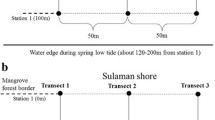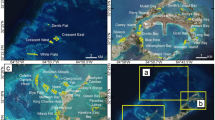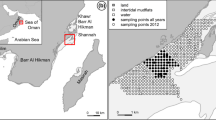Abstract
Distribution patterns of epibiotic barnacles on green sea turtles were investigated in waters neighboring Okinawa, Japan. A number of barnacle species were found to coexist on the turtles and were classified into three genera: Chelonibia, Platylepas and Stomatolepas. Attachment sites on the turtles varied among the barnacle species, suggesting that there is niche partitioning with respect to their microhabitat selection. Turtle bodies offer a “patchy” environment for barnacles, so we also analyzed coexistence patterns in the context of an aggregation model. Within each genus, individual barnacles showed a clumped distribution. The different genera do not have mutually exclusive distribution patterns, but instead occur on the same turtle to various degrees. However, when turtles were divided into two size classes, both the level of aggregation and the degree of interspecific overlap among the barnacles was significantly lower on large turtles. We suggest that obtaining basic information on turtle epibionts will shed light on the biology of wild turtles, which is still largely unknown.



Similar content being viewed by others
References
Atkinson W, Shorrocks B (1981) Competition on a divided and ephemeral resource: a simulation model. J Anim Ecol 50:461–471
Choy BK, Balas GH, Daily MA (1989) A new therapy for marine turtles parasitized by the piccolo leech, Ozobranchus branchiate. Herpetol Rev 20(4):89
Davenport J (1994) A cleaning association between the oceanic crab Planes minutes and the loggerhead sea turtle Caretta caretta. J Mar Biol Assoc UK 74:735–737
Hirate K, Kimura M (1996) Occurence of the “lost age” green turtle in Ryukyu island, Japan (In Japanese). Umigame Newslett Japan 29:10
Ives AR (1988) Aggregation and the coexistence of competitions. Ann Zool Fenn 25:75–88
Iwasaki K (1993) Synergistic effects of mixed grazing by intertidal limpets on sessile organisms: consequences of differences in grazing ability and feeding habit. Physiol Ecol Jpn 30:1–30
Kinne O (1985) Disease of marine animals, vol 4, part 2. Biologische Anstalt Helgoland, Hamburg, p 543
Kitsos MS, Christodoulou M, Arvanitidis C, Mavidis M, Kirmitzoglou I, Koukouras A (2005) Composition of the organismic assemblage associated with Careta caretta. J Mar Biol Assoc UK 85:257–261
Matsuura I, Nakamura K (1993) Attachement pattern of the turtle barnacle Chelonibia testudinaria on carapace of nesting loggerhead turtle, Caretta caretta. Nippon Suisan Gakkai Shi 59(10):1803
Monroe R, Limpus CJ (1979) Barnacles on turtles in Queensland waters with descriptions of three new species. Mem Qd Mus 19(3):197–223
Moore PG (1995) Podocerus chelonophilus (Amphipoda: Podoceridae) associated with epidermal lesions of the loggerhead turtle, Caretta caretta (Chelonia). J Mar Biol Assoc UK 75:253–255
Paine RT (1966) Food web complexity and species diversity. Am Nat 100:65–75
Seveneter J (1996) Aggregation and coexistence. I. Theory and analysis. J Anim Ecol 65:297–307
Shorrocks B, Atkinson W, Charlesworth P (1979) Competition on a divided and ephemeral resource. J Anim Ecol 48:799–806
Sokal RB, Rohlf FJ (1994) Biometry, 3rd edn. Freeman, San Francisco, CA, pp 820–824
Utinomi H (1969) Cirripedia of the Iranian Gulf. Vidensk Medd Dansk Naturh Foren 132:79–94
Van Buskirk J, Crowder LB (1994) Life-history variation in marine turtles. Copeia 1994:66–81
Acknowledgments
We are grateful to Kouichi Hirate of the fishery department of the prefectural office of Okinawa and Hidetoshi Ota of University of the Ryukyus for the advice on selecting the research site and for offering study equipments and materials. We also thank fishermen in Kanna fishery port in Okinawa and the Sea Turtle Association of Japan for help with field work. We also thank John Zardus of the Citadel, Military College of South Carolina, for discussions based on an earlier first draft, as well as Toshiyuki Yamaguchi of the Chiba University and William A. Newman of the Scripps Institution of Oceananography for helping us to identify these barnacles.
Author information
Authors and Affiliations
Corresponding author
About this article
Cite this article
Hayashi, R., Tsuji, K. Spatial distribution of turtle barnacles on the green sea turtle, Chelonia mydas . Ecol Res 23, 121–125 (2008). https://doi.org/10.1007/s11284-007-0349-0
Received:
Accepted:
Published:
Issue Date:
DOI: https://doi.org/10.1007/s11284-007-0349-0




